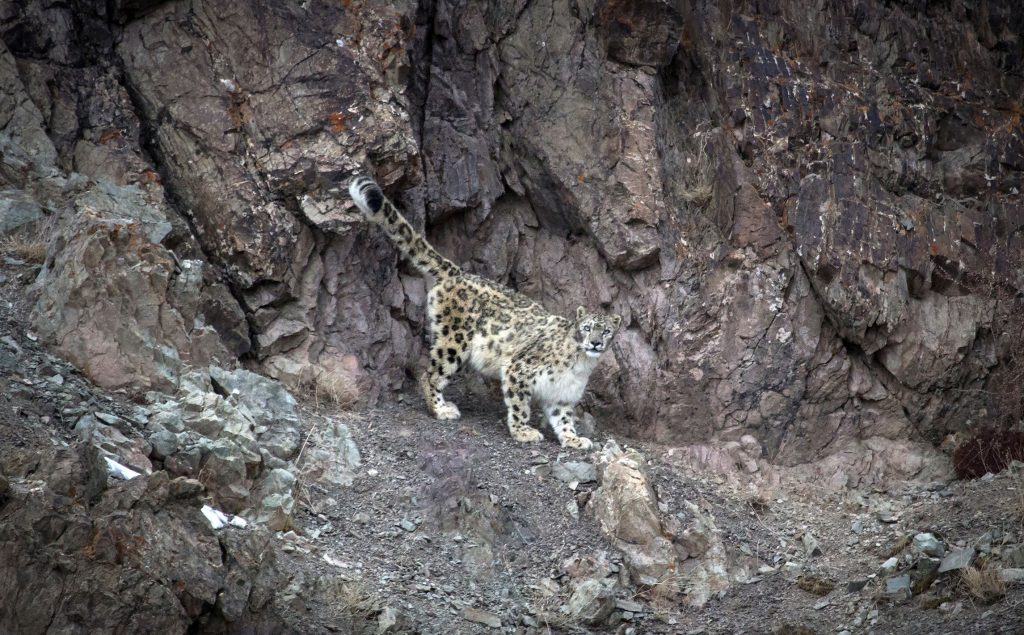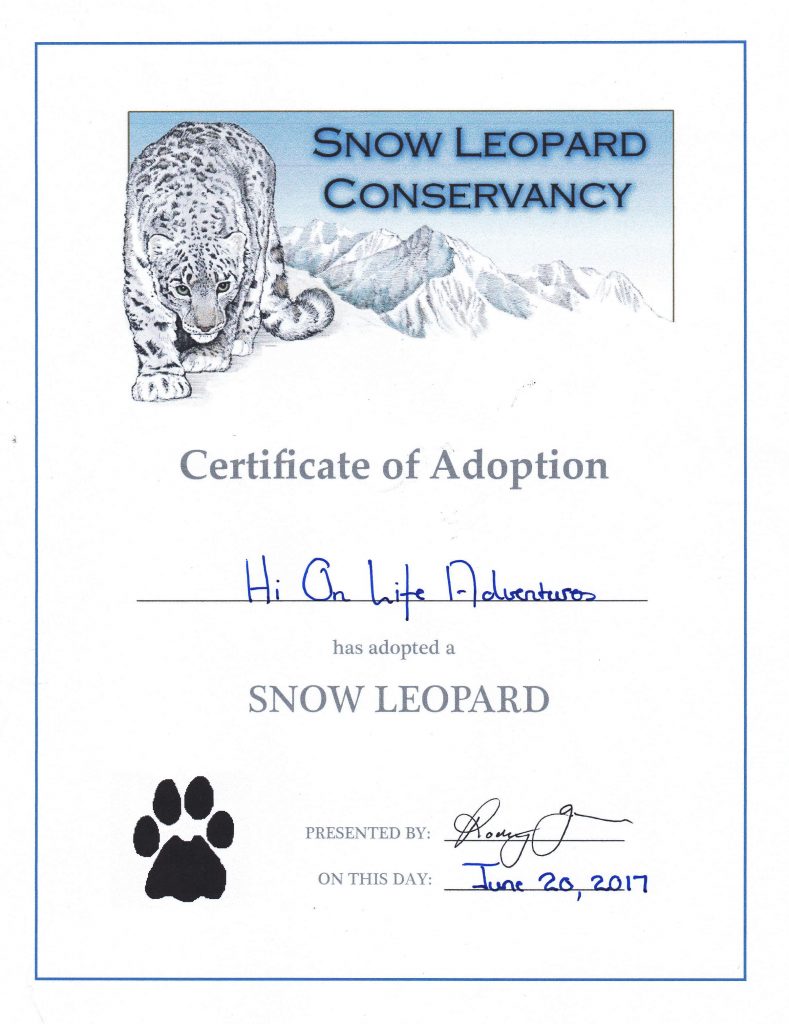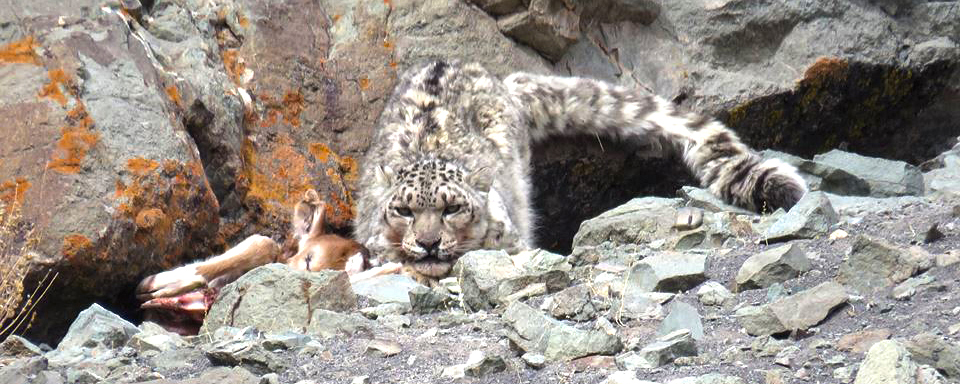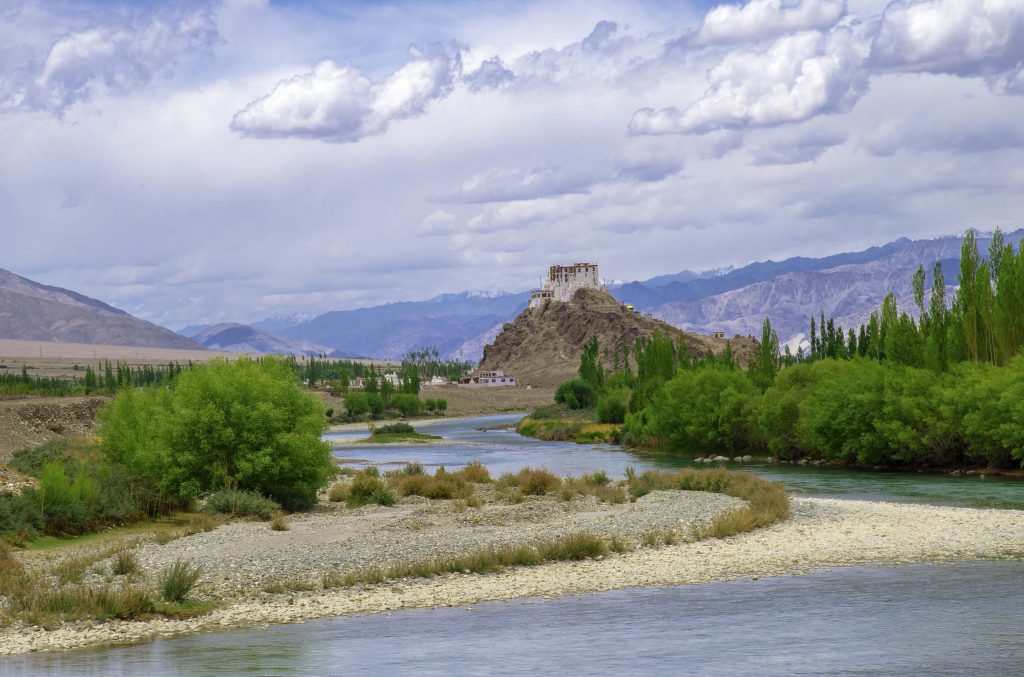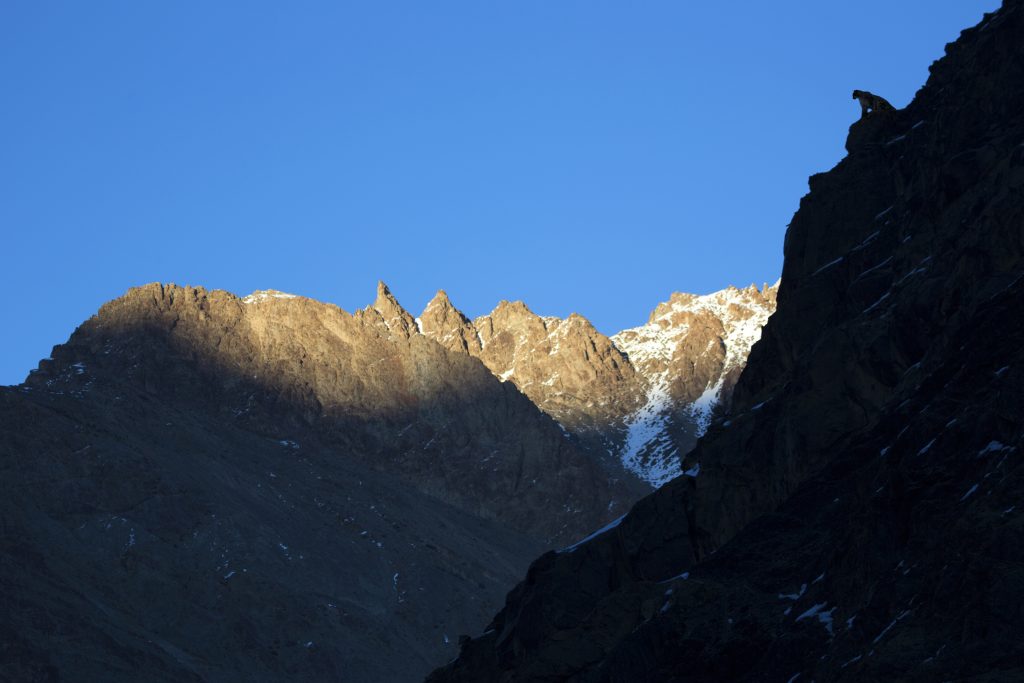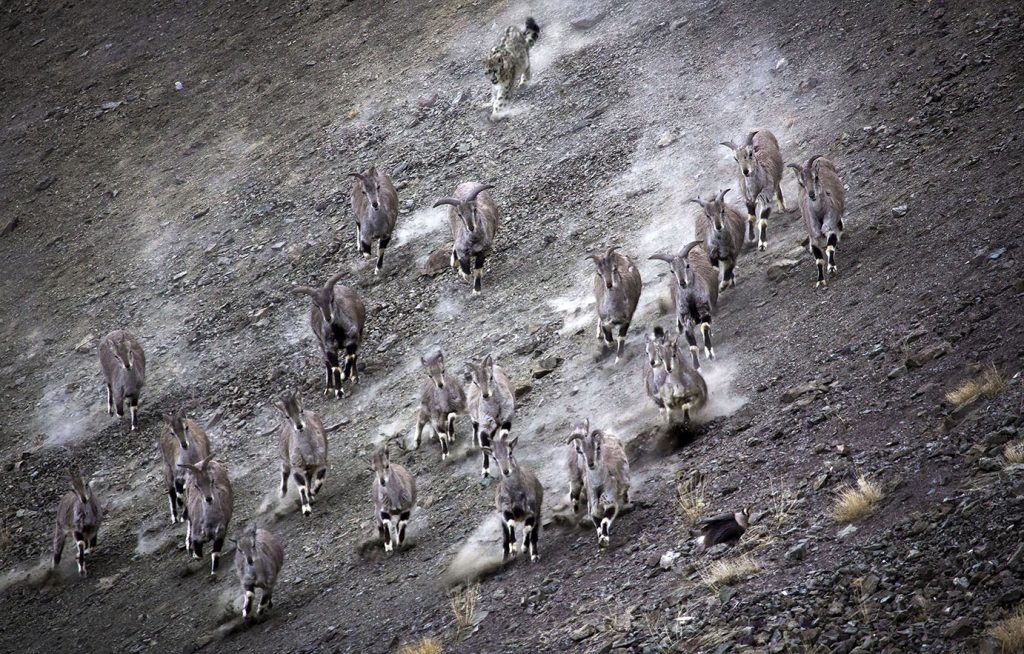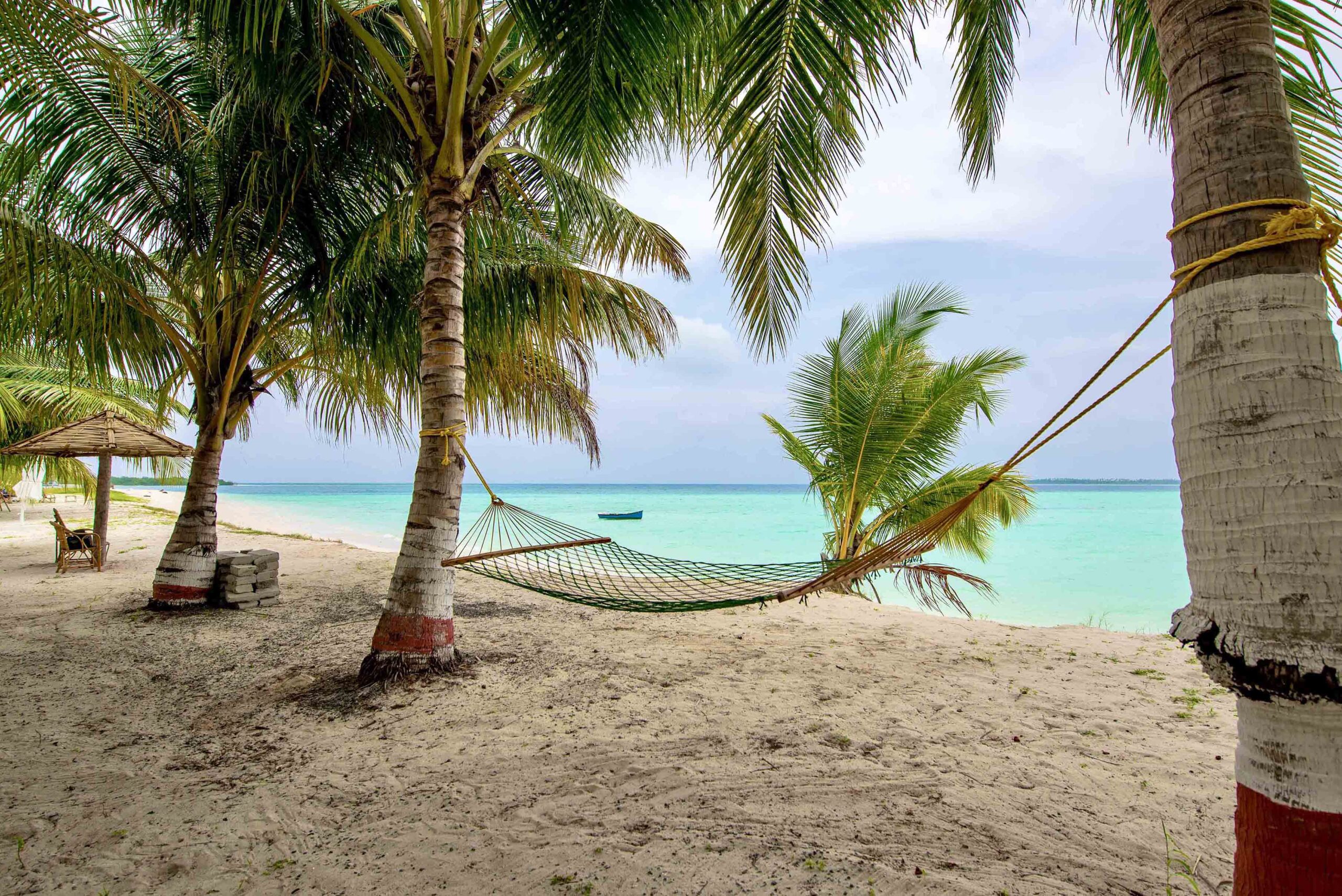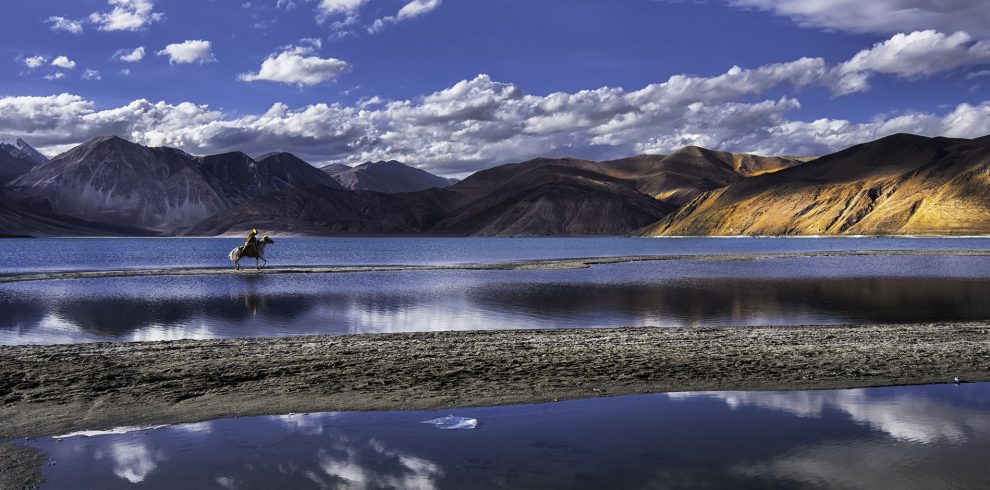“And then there was the small matter of the snow leopard, whose terrible beauty is the very stuff of human longing. Its uncompromising yellow eyes, wired into the depths of its unfathomable spirit, gaze out from the cover of innumerable editions. It is, I think, the animal I would most like to be eaten by.” ― Peter Matthiessen, The Snow Leopard
It is -25C; everything is frozen. Knife like cold air pierce through your cheeks and clouds of warm breath blurs everything in front of you. Surrounded by craggy rocky ridges of the unforgiving high mountains of the Himalaya, you will wonder- how can anything survive up here? Yet, this is the domain of the SNOW LEOPARD…..
Overview
This trip offers an excellent chance of seeing Snow Leopards in their natural habitat and the opportunity to capture it in your camera. The mountain valleys of the Himalaya are the domain of the elusive Snow leopard. They are more prominently spotted in the remote and starkly beautiful mountain valleys of Ladakh in NW India, close to Tibet. Bisected by the mighty Indus River, Ladakh’s vast rocky and dry barren landscapes, has an average population density of less than two people per square kilometre. This untouched part of the Himalayas has very little impact by human activities. People living in the areas that we visit are Buddhists of Tibetan descent. They are warm and friendly people who live in traditional mud and stone buildings, adorned with prayer flags. Hunting has never been part of the culture in this Buddhist region, so there are maybe no better places for the Snow leopard.
It is here that we will camp in a remote mountain valley with our team of expert local guides, who are naturally trained to spot the enigmatic and elusive inhabitant of the mountain: The Snow Leopard.
Trip Highlights
- Snow Leopard!
- Spectacular Mountain Flight to Leh the capital of Ladakh
- Sightseeing and Monastery visits around Leh
- 8 nights camping in Hemis National Park- the Realm of the Snow Leopard
- Breath-taking mountainous landscapes
- Sightseeing of Delhi- The capital of India
Itinerary
Altitude: 216m
On arrival to Indira Gandhi International Airport at New Delhi and finish with the immigration and custom formalities, our representative will meet you at the Main Exit with Hi On Life Adventures placard. It is about 15 to 20 mins drive to the Aerocity where we have chosen your hotel for the practicality for the next days early morning domestic airport transfer. When you arrive at your hotel you will be briefed about your trek and “do’s and don’ts” while your stay in India. In the evening we will have a welcome dinner to begin the taste of India at one of the finest dining in New Delhi. Overnight hotel
Altitude: 3500m
Flight duration: 1 hour 15 mins
Early morning drive to the domestic airport to fly to Leh. Be prepared for an extensive security checks for your own safety owing to the fact that Leh is strategically located close to Pakistan and China. The flight has strict regulation of 15 kg baggage allowance. It will be an early morning flight to Leh which is a fantastic mountain flight. The flight takes about 1 hour and 15 mins to Leh and approach to the airport at Leh is extremely scenic, so get your cameras ready. The airport at Leh is also an Indian Air Force Base, therefore it is heavily guarded and again extensive security checks. We will be received at the airport by a representative from Ladakh and will be transferred to our hotel. An important component of our trip that we must adhere to is the acclimatization required due to high altitude. Re-hydration is the key to cope up with the high altitude, so drink water regularly. We will take this first day at high altitude with leisure, maximum exertion should maybe be a small stroll outside to the neighboring shops.
Overnight hotel
Altitude: 3500m- 3100m
Sightseeing duration with drives: 6 to 7 hours
Today we visit the following:
Shey monastery and Shey Palace: built in 1655 by King Deldan Namgyal. The monastery is noted for its giant copper with gilded gold statue of a seated Buddha. Palace was used as a summer retreat by the kings of Ladakh. Thiksey monastery: It is a Tibetan Buddhist monastery of the Yellow Hat noted for its resemblance to the Potala Palace in Lhasa, Tibet.
Hemis monastery: A Tibetan Buddhist monastery of the Drukpa Lineage, located in Hemis, built in 1672 by the Ladakhi king Sengge Namgyalis. The annual Hemis festival honoring Padmasambhava is held here in the month of June or July.
En route, we explore the wetlands and riverbanks along the Indus, including the thick buckthorn patches, the shoreline and grazing land. These areas are excellent for many species including Water Rail Rallus aquaticus, White-winged Redstart Phoenicurus Erythrogaster and Streaked Rosefinch Carpodacus Rubicilloides during the winter months.Overnight hotel.
Drive: 25 kms, 45 mins
Trek distance: 5 km, 1 ½ hours
Elevation of Zingchen: 3400m
Elevation of Husing Camp: 3900m
After breakfast we drive 23 kms to Zingchen which is the entry into Hemis National Park. After completing registering permits and other formalities, we begin our trek to Husing. There are chances of spotting the Urial, Bharal during this hike. This area also provides opportunities to see Red Foxes, Lammergeyers and Golden eagles. On arrival at Husing, we will be welcomed with hot tea / soup, followed by tent allotment and hot lunch. After lunch, we will explore the area nearby Husing camp. Snow leopards are regularly spotted here. Our trackers would be on it!Meanwhile, we can enjoy some bird watching. There are chances to sport the Wallcreeper and the Ibisbill. The adjacent hills are the territory of red foxes which can sometimes be seen hunting for the Tibetan Snowcocks. After a late evening session, we return to the campsite. Overnight camp
We will have a fixed camp for a week at Husing and/or Rumbak village separated by a distance of 6 kms. Each day, at dawn and dusk, our trackers will set out to see movements of the snow leopard as these cats are mostly active during night and at dawn/dusk. We will explore the Tarbung valley, Rumbak valley and other ridges along the river to spot the big cat.
Our guides will look for various leads to spot the Snow Leopard, following pugmarks, scar marks, mating calls etc. while our spotting scopes would be at work from vantage points around the Husing camp. An important lead for the trackers is the activities of the Bharal, as they being the main prey for the Snow Leopards. Winters are also the mating season for the Snow Leopards, hence the mating calls would help us track movements of females and males towards each other. Evenings are more productive in spotting Snow Leopard as most resting snow leopards start moving at evening.
Each day, all the trackers from different groups meet back at Husing camp for sharing their information and tracks.
Trek: 1 hour 30 min to Zinchen
Drive: 25 kms, 45 mins
Today we pack up our camp and head back out to Zingchen, which is an hour and a half walk. Here we take our vehicle and drive back to Leh. The afternoon can be spent walking in the main Bazaar and shopping. Overnight hotel.
Flight duration: 1 hour 25 min
Afternoon sightseeing of Delhi
We fly early morning to New Delhi. Due to airport security regulations, NO CABIN BAGGAGE allowed on any flights originating from Leh.
Upon arrival to Delhi, we drive to Aerocity and check in to our hotel. At around 3 PM we will take a sightseeing tour of Old Delhi.The sightseeing begins with a drive through the historical monuments and government buildings of New Delhi. New Delhi was established by the British and most of the buildings were built in the Lutyen style. Sir Edwin Landseer Lutyens, was an English architect known for imaginatively adapting traditional architectural styles to the requirements of his era. He designed many English country houses, war memorials and public buildings in New Delhi.After a short drive through New Delhi, we enter the heart of Delhi, the Chandni Chowk. Suddenly you are in another era of history and culture. We will take a rickshaw ride through the narrow lanes of the Spice Market and Bride’s market, more commonly known as the Khari Baoli. It is a fascinating ride where you can witness real India, with people literally walking over each other, deafening noise along with the vibrant colors that Indian is known for, and intriguing aroma of the spices and food.Overnight HotelDay 14: Departure- Trip endsYou will be transferred to Indira Gandhi International airport 4 hours before your flight departure time.
Price Includes
- From arrival in Leh, until morning of departure from Leh:
- All internal transportation in private vehicle
- Receive at New Delhi airport and transfer to Hotel
- 2 nights at 5 star hotel in new Delhi
- Welcome dinner
- Sight seeing of Delhi with Rickshaw ride
- Delhi/ Leh/ Delhi domestic flight fare
- 3 nights at 3 star hotel in Leh with all meals
- Guided Sightseeing in and around Leh with all entrance fees
- 8 days Camping with all camping facilities
- Safari style single cottage tent with comfortable camping bed and matresses
- Kitchen tent, Dining tent with comfortable tables and chairs, toilet tents,
- Serives of English speaking guide
- Serivcies of Cheff and kitchen helpers
- Mules and horses for transfering of baggages
- All meals while on trek with unlimited supply of hot beverages and biscuits and snacks
- All Camping fees, Wildlife fees and Snow Leopard Conservation fee
Price Excludes
- Insurance: Travel/Accident/Medical /emergency evacuation
- Private room accommodation in Delhi and Leh unless a single supplement is paid.
- Staff tipping
- Indian Visa
- Telephone, laundry, mineral water, soft drinks and alcoholic beverages.
- Emergency rescue evacuation cost if needed
- All other personal nature expenses.
About Ladakh
Ladakh, “The land of high passes”, is a region in the Indian state of Jammu and Kashmir. Although, rock carvings found in many parts of Ladakh indicate that the area has been inhabited from Neolithic times, not much is known about Ladakh before the 1st century. During the 2nd century when much of eastern Ladakh and western Tibet was still practicing the Bon religion, Buddhism started to spread into western Ladakh from Kashmir. In 842 Nyima-Gon, a Tibetan royal prince annexed Ladakh after the break-up of the Tibetan empire, and founded a separate Ladakhi dynasty. During this period, Ladakh acquired a predominantly Tibetan population. Also known as “Little Tibet” Ladakh’s culture and history are closely related to that of Tibet.
The largest town in Ladakh is Leh, followed by Kargil. Ladakhis are Tibetan-Mongoloid in appearance although traces of Kashmiri Moslem influence can also be seen. The predominant religion in Ladakh is the Tibetan form of Buddhism, although Islamic influences are found from the Kashmir Valley as far as Kargil, and there are some Christian families in Leh.
Some interesting facts about Ladakh
- Ladakh is the highest settlement in India.
- The fields at Korzok, on the Tso-moriri Lake, at 4,600m are widely considered to be the highest cultivated lands in the world.
- A Bailey bridge between the Suru River and Dras River in Ladakh, is the highest bridge in the world at an altitude of 5,602m.
- Only place in India where twin humped Bactrian camels can be found.
- Ladakh is home to the mystical Magnetic Hill, which is a so-called “gravity hill”. The alignment of the road with the slope of the background can give the illusion that cars are able to drift upwards.
- The Pangong lake in Ladakh is one of the highest salt lakes in the world
- Ladakh is also home to some of the rare species of wildlife including Snow Leopard, Kyang (wild ass), Black Necked Cranes, Himalayan Ibex and several other species of brids and animals.
Trip summary
You arrive at New Delhi and begin this fantastic tour with a spectacular mountain flight to Leh, the capital of Ladakh. Cut off by road from the rest of India for the five months of winter, life is sedate and far slower-paced than almost any other town anywhere on the sub-continent. It is not until the onset of summer, in May, that Leh gets busy. We will stay two nights to help us acclimatize to the altitude – at 3600m. During these two days, we will take a sightseeing tour of the monasteries around Leh and explore the banks of the Indus in search of enigmatic birds such as Ibis bill, Solitary Snipe and Gouldenstadt’s (White-winged) Redstart. The shops in Leh offer the last chance to purchase any items that you may have forgotten.
After Leh, we head off to the mountains. Ten nights of camping in an area where Snow Leopards spend the winter is the main objective of the tour. We have carefully chosen the timing, towards the end of the mating season and the coldest temperatures of winter to try and spot the Snow Leopard. The winter snows in this arid environment drives the Snow Leopards and their prey, the Blue Sheep, to lower elevations which are almost snow free, concentrating them in a smaller area. This offers an easier access to look for them and a better chance to spot them. We will have local guides who know the area, and the habits of the Snow Leopards. By keeping in radio contact with the park rangers and other local guides we will increase our chances of seeing leopards even more.
The chance for photographing Snow Leopard is moderate, as any sightings will probably be at some range, so big lenses and converters are the best options. Viewing with spotting scopes however can be extremely rewarding. During the daytime, as most cats do, the Snow Leopards snooze, thus providing a prolonged period of spotting, if and when they are spotted. However, as the sun sinks, the viewing conditions return to optimal just as the Snow Leopards typically arise from their afternoon nap.
Almost all the companies operating this tour provides small dome tents during the camping and most customers complain about the uncomfortable and cold nights having to crouch into the tiny tent at -25C. We provide safari style tents with folding beds for comfortable sleeping and heated dining tent.
The following can be spotted during the trip:
Potential Mammals
Snow Leopard Lynx Wolf
Mountain Weasel Blue Sheep (Bharal) Asiatic Ibex
Tibetan Argali Ladakh Urial (Red Sheep) Woolly Hare
Royle’s Pika Pika spp Red Fox
Potential Birds
Himalayan Snowcock Tibetan (Hill-)Partridge
Chukar Gadwall Mallard
Goosander Northern Pintail Common Teal
Rock Pigeon Hill Pigeon Snow Pigeon
Solitary Snipe Common Snipe Common Redshank
Common Greenshank Green Sandpiper Ibis bill
Lammergeyer Himalayan Griffon
Eurasian Sparrow hawk Northern Goshawk
Golden Eagle Common Kestrel Great Cormorant
Magpie Red-billed Chough Carrion Crow
Common Raven Brown Dipper
Blue Whistling-Thrush Common Starling Wall creeper
Eurasian Wren Great Tit Horned (Shore) Lark
Tibetan Snow finch White Wagtail Water Pipit
Robin Accentor Brown Accentor
Fire-fronted Serine Brandt’s Mountain-Finch
Mongolian Finch Great Rose finch Little Owl
Red St Mountain Chiffchaff Rosy Pipit
Robin Accentor Brown Accentor Fire-Fronted Serin
Twite Rose Finches
Yellow-billed (Alpine) Chough Dark (Black) -throated Thrush
White-winged (Gouldenstadt’s) Redstart White-browed (Stoliczka’s) Tit-Warbler
Daily activities in camp
The calls of Himalayan Snow cocks and Chokers are most likely the first sound that you will hear each day. The day usually begins with a wake up around 7 with hot tea/ coffee followed by a bowl of warm water for washing.
Our guides will be already on the lookout for Snow Leopards, either from camp, or from a vantage point close by. You can choose to join them on the lookout, or take your time and have a leisurely start. Breakfast will be served in the dining tent which is heated by a gas fire heater. After breakfast we usually take day hikes in the potential areas for Snow Leopard sighting. While you are away on hikes trying to spot different animals and birds during the daytime, you will be provided with packed/ hot lunch. You will also be provided with hot tea, coffee and snacks.
Most of the hiking will be on gentle inclines, on primitive trails, but occasionally we may want to get into a better position for viewing which may involve much steeper walking for short distances. The hikes up the hill sections are taken at a slow pace due to the altitude. You will certainly notice the reduced amount of oxygen when walking uphill. Basically, the amount of hiking you choose to do is entirely up to you, but within certain parameters. You need to carry a small daypack with extra warm jacket, camera and water.
We will have around 12 hours of daylight a day, which is beneficial to spot the Snow Leopard, and an ample amount of time for our day time activities. We usually go to bed early to ensure long good night’s rest, although it is a welcoming “disturbance” to be woken up in the night by the mating call of a Snow Leopard, the bark of a Red Fox, or the howling of Wolves while running their nightly errands.
Facilities at camp
Our camps have comfortable safari tents with an inside layer made with insulated dacron filled wall. Folding beds with thick insulated mattresses are provided with expedition weight -25C sleeping bags. The mess tent is a double layered winter season tent heated by a gas fire heater, with tables and chairs. Toilet tents and shower tents are also provided. We will provide a generator and solar power that we will use occasionally for battery charging, if and when needed.
The camping is full service and we will be very well looked after, with a whole team of cooks and camp helpers attending to our needs. Usually lunch is more likely to be a picnic with hot soup, a hot main course and tea/coffee, brought to us almost no matter where we have walked to. The cook and the kitchen crew prepares hot food which is normally a very balanced diet comprising of fresh vegetables and breads, to pastas and sandwiches and occasionally even cakes and pizzas. Breakfasts are usually bread eggs and cereals, and lunch and dinner are a three course meals. We make sure that you get the required amount of carbohydrates and proteins and vitamins, so plenty canned vegetables, canned meat and fish and eggs and cereals are carried. We provide boiled and treated water 4 times a day. As Ladakh is cut off by road for the entire winter, there will be very few, if any, fresh vegetables.
Weather
Expect daytime temperatures to rise close to freezing, or, on sunny slopes, above that.
The early morning low can be around -10c to -15c although it could be colder, sometimes even down to around -25c.
Clear conditions will be interspersed with cloudier, even overcast days. We are in an area that is in a “rain” shadow, so heavier snowfalls are unusual, but we can expect some light snowfall occasionally, about 2 to 4 cm. Generally there is little wind – although a slight breeze often picks up on the afternoons.
Hotel accommodation in Delhi and Leh
While in Delhi, you will stay at a 5 star hotel on Bed and Breakfast, and in Leh you will stay at a traditionally built 4 star hotel. All meals are provided at the hotel while your stay at Leh. During the winter months in Leh, the pipes freeze, so it is likely that hot and cold water will be provided in buckets. Electricity and internet can be expected, but not guaranteed.
Recommendations for things you should bring:
Clothing:
Head
- Warm hat wool or synthetic that covers your ears
- Sunhat
- Sunglasses Polaroid or Category 2 minimum
- Headlamp with extra batteries and bulbs
- Bandana or head scarf, also useful for dusty conditions
Upper body
- 2 cotton t-shirts
- 2 polypropylene long sleeve t-shirt
- 2 long sleeve thermal underwear shirts, lightweight
- 2 long sleeve thermal underwear shirt, heavy weight
- 1 polar fleece or prima loft or thin down jacket
- Gore-Tex jacket with hood, waterproof and breathable
- 1 Heavy goose down jacket Please note: We will provide adequate down jacket, but you may bring your own if you want.
Hands
- 1 pr. lightweight poly-liner gloves
- 1 pair wind stopper working glovs
- 1 pair down/ prima loft mittens
Lower Body
- 1 pair walking shorts
- 1 to 2 pair walking trousers for trekking and around camp
- 2 pair lightweight thermal bottoms
- 1 pair heavy weight thermal bottoms
- 1 pair primaloft/ medium weight down trouser
- 1 pair Gore-Tex trousers, Waterproof/breathable with side zips
Feet
- 1 pair treking /walking boots with good ankle support
- 1 pair trainers, running shoes and/or sandals for Delhi and in camp;
- 1 pair down booties (optional)
- 2 pair heavy preferably wool socks
- 3 pair liner preferably wool socks
- 1 pair lightweight trekking socks, wool
Sleeping
1 down sleeping bag (rated comfort -20 C or -4 F ) Please note: We will provide adequate sleeping bag, but you may bring your own if you want.
Rucksack and Travel Bags
- 1 medium rucksack (40-60 litres)
- Small padlocks for duffel kit bags.
- We provide you 2 big duffle bags.
Assesories
- 1 small roll of repair tape, 1 sewing repair kit
- 1 cigarette lighter
- 1 compass or GPS (optional)
- Nylon stuff sacks for food and gear storage, large Ziplocs are useful also
- 1 Water bottles (1 litre)
- 1 plastic cup and spoon
- 1 small folding knife
- Books, playing cards, ipod/mp3 player, games, musical instrument etc
- Camera
- Adequate amount of batteries
- Binoculars
- Telescope, tripod
- Camera + lenses / dig scoping kit
- Sunscreen
- Wet wipes
- Hand sanitizers
- Essential medications for at least one week longer than the intended duration of the trip
- Personal Toiletries.
High Altitude
On this trek you will be going up to 4500m, so it is very important to understand the affects of altitude. The greatest provocation is going too high too fast. Basically, on this trip you are camping at one spot and only taking day hikes, nevertheless, it is still recommendable to take symptoms of altitude seriously. Headaches and breathlessness are common at altitude which in itself is nothing to worry about. In rare cases, this may worsen to Acute Mountain Sickness (AMS), so a close watch is kept on all trekkers by the group leader who is trained to recognize the symptoms of AMS which are severe headaches, nausea, lethargy, loss of appetite serious breathlessness even at rest. If any trekkers show such signs they will be descended to relatively lower and safer altitude. The Group Leader’s decision on evacuating such person to a safe altitude is final. Do not medicate yourself without first informing your group leader. Going to altitude slowly with adequate rest and adequate intake of fluid (3 to 4 litres per day), you will most likely have no problems apart from breathlessness on hills which is completely normal as the percentage of Oxygen in the air is relatively lower to that at sea level. The most important thing is not to worry about altitude because our team is there to take care of you.
Insure yourself:
We highly recommend you to take a comprehensive Personal Travel Insurance before leaving home. This should cover for your loss of baggage, airline delays, sickness, and accidents. It should cover all incurring costs for evacuations.
Money Matters
The ideal currency to bring with you is USD or Euro. You can exchange them in Delhi or Leh. You can also draw money from ATM machines in New Delhi or Leh.The exchange rate is 1 USD = 68 Indian Rupees approx. (subject to change)
In Delhi and Agra: Delhi has a wide variety of restaurants with a very wide range of price. Depending on where you eat, each meal will cost anything between 5 to 25 USD + drinks. Plus 20 to 30 USD for your taxis if you wish to go around the city.
On trek: Basically there are no place where you can spend money on the trek. However, in few places you might find small tea shops that sells cold drinks, chocolates etc. It is recomended to bring around 5 USD per day. This money is chocolates, soft drinks and beers etc and also for small donations in the monasteries.
Tipping
Although tipping is entirely optional and personal matter the following is recommended as a guideline
In Delhi and Leh: for bellboys, waiters and porters 50 to 100 Indian Rupees
On the trek: At the end of the trek it is a customary to tip the field staff. The recommended amount is 100-150 USD depending on group size. The Group leader will collect the tip and then split it between the staff and put it in envelops so that the trekkers can give it to the staff during the “Farwell Ceremonies”.
Some Do’s and Don’ts
Ladakhki people treat visitors as special guests. Although they will never rebuke you publicly for unknowingly offending them, we must consider their culture.
While in Ladakh please observe the following:
- Full or partial nudity is not accepted.
- Over display of affection between men and women, especially in temples and monasteries are discouraged.
- Please remove your shoes before entering monasteries and temples.
- Never point the soles of your feet at a person or shrine.
- Locals walk around the Mani walls and Stupas in a clockwise direction as a respect and they expect you to do the same although it is not compulsory.
- Please ask before taking pics of a person or his/her child
Some useful tips while travelling in Delhi and other parts of India if you have booked and extension
Dress code: Dress sensibly and don’t walk around alone at night. For men knee length shorts and t shirts and sandals are best to cope up with the heat but in some temple and mosques you need to wear long trousers. For women it would be wise to cover up and dress modestly to avoid unwarranted advances. Light cotton trousers or knee length skirts are ideal and avoid bare back dresses.
Personal space: The concept of personal space is almost nonexistent in almost all over India. Whether you’re standing in a queue or walking in a crowded Bazaar, get used to moving shoulder-to-shoulder.
People in North India tend to stare a lot: Please don’t be offended because most of them do this out of curiosity. Easy way to deal with this is to not make direct eye contact with strangers and passersby. Get used to it and don’t let this make you uncomfortable.
Bargaining skills: In shopping malls the prices are fixed and you cannot bargain. However, in rest of your shopping adventure, it is inevitable that you will be exploited to a certain degree, the simple fact is that most vendors know you have money. Skillful bartering takes practice- a beginner’s rule of thumb is to cut the
starting price in half and then work your way to a middle ground.
Beware of Pickpockets: The streets of Delhi can become very crowded, exposing you up to a risk of being easily pick-pocketed. Keep your money in your money belt or in a forward facing backpack to avoid any thieves. If you need to take money out of your wallet, it is best to find a quiet spot and do it quickly to avoid being robbed.
Beggars: You will likely see things that strike your emotional core, but it is important to realize that these are deep rooted problems with no easy fix. Moreover if you give money to one beggar, within secs you will find yourself surrounded by a dozen other beggars from children to adults. Also keep in mind that beggar mafias control much of the inner city.
Street Hawkers: When you walk out of the sightseeing points you will meet several hawkers trying to sell you small souvenirs from pics and all sorts of things. Do not engage in a bargain or converstation unless you really want to buy them. They can be very pushy sometimes.
Go With the Flow: Despite the fact that the cities in India can be tiring with all the staring, crowded streets, beggars, pestering hawkers’ etc. try not to care about the small stuff. If you get caught up and stress about the little things, you will miss out on the bigger picture, which is that you are in one of the most distinctive and important cities in the world. The city will often come to feel like another planet entirely.
“TODAY IS YOUR DAY! YOUR MOUNTAIN IS WAITING, SO… GET ON YOUR WAY!”
DR. SEUSS


